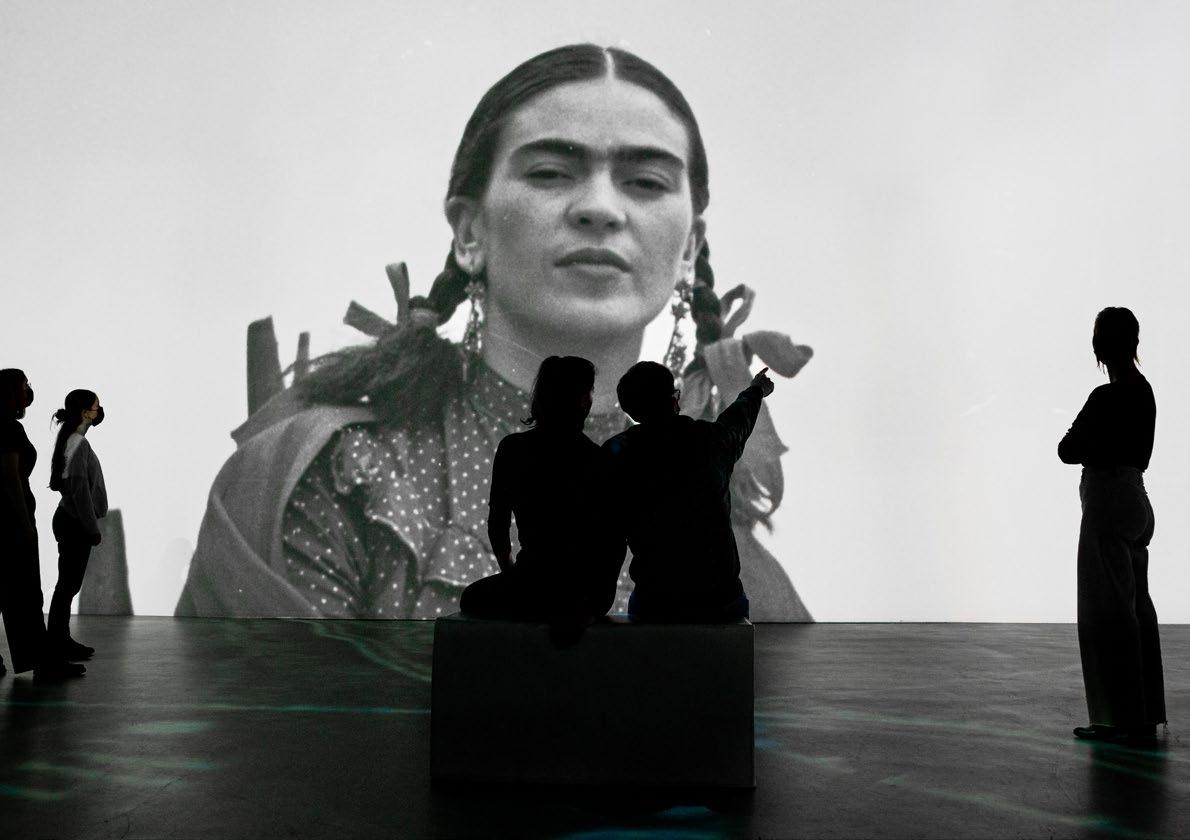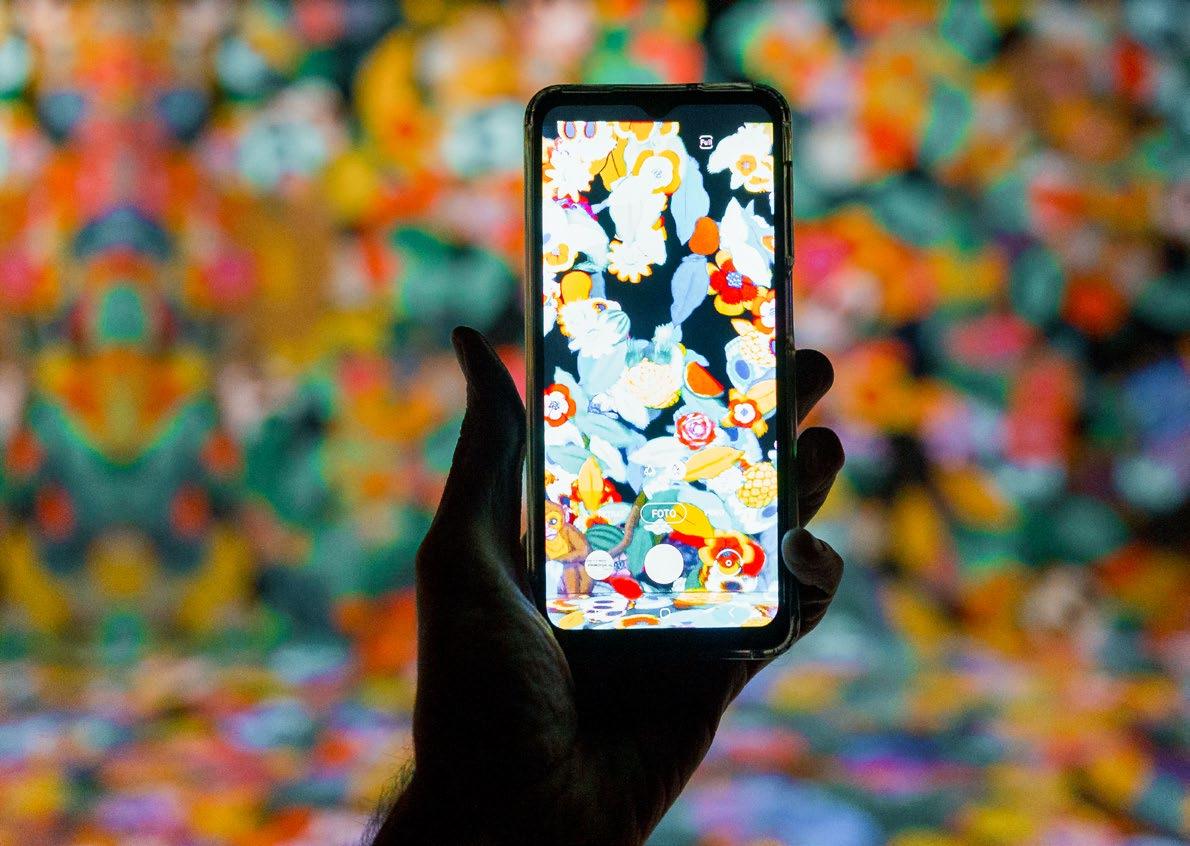FRIDA KAHLO EDUCATION PACK








Frida Kahlo started painting when she was bed bound in hospital recovering from the life-defining bus accident that happened when she was 18. Her parents set up an easel next to her bed and a mirror above, and as she recovered over many months she began to practice painting. “I paint self-portraits because I am so often alone,” she said, “because I am the person I know best.”
Out of all her work, about one third is self-portraits, with each approaching the presentation of her identity in a slightly different way, whether as a woman, lover, revolutionary Marxist or proud “Mestizo” (part Spanish, part-Indigenous) Mexican.
Both Kahlo and her husband Diego Rivera were influential in the renewed surge of Mexican national pride in the early 20th Century that embraced the country’s Indigenous, pre-colonisation roots. Kahlo embraced Mexican folk art traditions, including motifs from Day of the Dead celebrations in her work, as well as motifs from Aztec mythology, such as skulls, skeletons, hearts and blood. Although she was included amongst the Surrealist movement of the era for the fantastical elements of some of her paintings, she never
considered herself to be a Surrealist. “They thought I was a surrealist, but I wasn’t,” Kahlo said. “I never painted dreams. I painted my own reality.”
By painting herself wearing men’s suits, in bed with other women, as an injured or disabled person, or as a powerful goddess or saint-like figure, Kahlo challenged the narrow range of acceptable depictions of women in Mexican society and showed that women could be strong, independent and multi-faceted.
In her final years, though, Kahlo moved away from self-portraiture to still

life paintings of fruits and flowers, perhaps as a way to deal with her own mortality. “I paint flowers so they will not die,” Kahlo said.
Kahlo enjoyed celebrity status in Mexico and the United States as ‘Diego Rivera’s wife’ by the time of her death at age 47, and her state funeral drew hundreds of grieving admirers.

She had been photographed for Vogue, inspired fashion collections with her traditional Oaxacan dress, and her painting The Frame’ became
the first Mexican art purchased by The Louvre. But it wasn’t until the late 70s when feminist and queer scholars reappraised the impact of her work that she was recognised and celebrated as a ground-breaking feminist and LGBTQ artist. She was one of the first truly modern artists, who built an instantly recognisable identity and mythology around herself, but it was always in service of her campesinos (countryfolk) of Mexico.
Frida Kahlo’s life would be framed by ill health – childhood polio left her with a misshapen right leg, and at age 18, the bus she was travelling home from school on was hit by a streetcar, injuring her grievously. Her spine was broken in several places, along with her ribs, collarbone, left shoulder and right leg. Her pelvis was shattered and a metal handrail pierced her abdomen and womb, leaving her unable to bear children. The accident would leave her in constant pain for much of the rest of her life with multiple surgeries to undergo – by the time of her death at 47, she was addicted to painkillers and drinking heavily.
But Frida Kahlo was never a victim – she understood the power of her own image and everything she did, from wearing traditional Oaxacan clothes that signaled her pride in her Mexican identity, to her forthright poses in photographs, was calculated to create her mystique as an artist. “I knew the battlefield of suffering was reflected in my eyes,” Frida said, “Ever since then, I started looking straight into the lens, without winking, without smiling, determined to prove I would be a good warrior until the end.”

Mexico in the early 20th Century was marked by a huge financial gap between the wealthy middle and upper class, and the mass poverty of the workers and farmers. An armed revolution in 1910 led to years of civil war and political instability. Both Frida and Diego were Marxists committed to closing the gap between the rich and poor and empowering workers. They were both members of the Communist Party of Mexico, until Diego was expelled in 1929 for accepting a commission from the US Ambassador and “colluding with an anti-communist regime”. Frida resigned from the Party in solidarity.
They continued to make highly political art – Diego, large social realist murals romanticising the worker, and Frida politicising the personal in her self-reflective work – for the rest of their careers. In 1937 they convinced the Mexican President to grant political asylum to exiled communist leader Leon Trotsky, installing him and his wife Natalia Sedova in their home at Casa Azul.
Trotsky and Frida had a brief affair, when Rivera found out, he and Trotsky had a falling out and he expelled him from Casa Azul to his own apartment, where he was later assassinated by an undercover agent working for his rival Stalin.


Frida was only 22, and recovering from her traumatic bus accident, when she married the already-famous painter Diego Rivera, 20 years her senior. They saw in each other spiritual comrades in art and the Marxist struggle; Rivera said, “I did not know it then, but Frida had already become the most important fact in my life. And she would continue to be, up to the moment she died.”
Their relationship was not smooth sailing though – Rivera was a notorious womaniser, a fact Frida acknowledged, saying “Diego is not anybody’s husband and never will be, but he is a great comrade.”
Kahlo had many affairs of her own,
with men and women, including jazz singer Josephine Baker, painter Georgia O’Keefe, sculptor Isamu Noguchi and famed communist Leon Trotsky. Rivera turned a blind eye to the women but would become enraged whenever Kahlo had an affair with another man. The turbulence of their relationship aside, there can be no doubt they were obsessed with each other. “I love you more than my own skin and even though you don’t love me the same way, you love me anyways, don’t you?” Kahlo famously said of Rivera. “And if you don’t, I’ll always have the hope that you do, and I’m satisfied with that. Love me a little. I adore you.”

• In what ways was Frida Kahlo’s art rebellious or boundary-pushing for its time, the 1920s to 1950s?
• What techniques did Frida Kahlo use to build and maintain her image or self-mythology?

• How did Frida Kahlo’s nationalist pride and socialist beliefs influence her paintings?
• If Frida Kahlo were an artist working now, what medium do you think she would be working in? Do you think she would still be a painter, or making a different type of art?
1Select two different Frida Kahlo paintings and compare and contrast the differences between them. If they’re both self-portraits, how does her representation of herself differ between them? Or if one is vastly different to the other, what do you think she is trying to say in each artwork?
2Imagine you are an artist trying to establish yourself like Frida –how would you establish your own personal mythology? What distinctive clothes would you wear that are important to you; what social or political causes would you champion; what would your style of art be and what themes would it deal with? How important is the way you present yourself in defining the way your work will be interpreted?
3Consider Alejandro Gomez Arias’ quote: “Who was Frida Kahlo? It is not possible to find an answer, so contradictory and multiple was the personality of this woman that it may be said that many Fridas existed –perhaps none of them was the one that she wanted to be.” Using her self-portraits and paintings as a guideline, identify some of Frida’s different personas that she played throughout her life and note the paintings where she portrayed herself as that person in her art.
4Frida and Diego’s politics were an important part of their lives and artistic practices – they were both communists who rejected capitalism and materialism and surrounded themselves with native plants and artefacts from pre-colonisation South America, while also enjoying the society of film stars, musicians and art world celebrities. Consider how Frida Kahlo’s work can be considered as “political art” – is it political? What elements make it political? Then create your own personal/political self-portrait using a selfie and props/clothing/background to communicate what you want to say.

• Frida Kahlo was very proud of her Indigenous Mexican heritage on her mother’s side – how did she express her pride through her art, what she wore and where she lived?
• Pain was an important part of Frida Kahlo’s art practice, both the physical pain from her disabilities and emotional pain from her complex relationship with her husband Diego Rivera. Discuss how Kahlo uses her artwork to turn her pain into a source of personal power.
• Although very famous as the “wife of muralist Diego Rivera” while she was alive, Kahlo stature as a great feminist painter was not recognised until the late 70s. Discuss some of the reasons for that.
• Discuss how Kahlo’s “personal brand” and the way she represented herself helped to make her an instantly recognisable figure now.

1Compare and contrast two different Frida Kahlo self-portraits, for example, Self-portrait with Thorn Necklace and Hummingbird (1940) and Self-portrait with Cropped Hair (1940) and discuss how she has presented herself differently in each picture. Think about things such as: what is she wearing in each picture; how is she wearing her hair; what is her expression; does she have any animals or props with her; what background has she painted herself against? What do you think she is thinking in each picture?
Think about how you would style your own self-portrait to express your personality: what would you wear, how would you do your hair, what would be in the background, would you have any personal objects or pets in the picture, would there be anyone else in the picture?

Then write down and explain your picture and, if you like, sketch a version of it.
3Frida Kahlo is famous for her self-portraits. “I paint selfportraits because I am so often alone,” she said, “because I am the person I know best.” She also had a turbulent life of experiences to draw upon for inspiration for her art, from her accident and resulting physical pain, to her unstable relationship with husband Diego, her many lovers and friends, her trips to paint and exhibit in Europe and the USA, and her Indigenous Mexican roots. If you were to become a painter, what source material would you draw upon and what do you think would be the main subjects of your art?